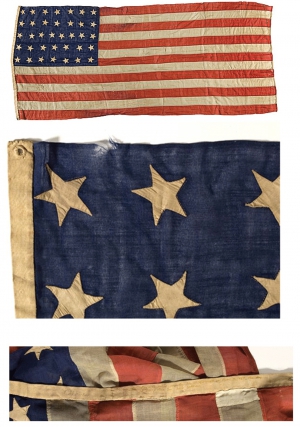Click to enlarge:

The Stars and Stripes returned to Richmond, Virginia, on April 3, 1865, the day of Union occupation. As soon as federal troops stormed the fallen Confederate capital, U.S. flags were hoisted all over the city. This 36-star flag was one of the first flags raised above Richmond that day. It is believed to have been owned by a Private J.H. Jones, a Union soldier.
[CIVIL WAR].
Ephemera. 36-star Union flag flown over Richmond on April 3, 1865. Inscribed on header in yellowed ink by probable owner
“J.H. Jones Pvt.”, with an additional inscription (possibly stenciled)
“C. M. Fisher.” 122½ x 54 in.
Inventory #21674
SOLD — please inquire about other items
Transcript
[Inscribed:] “This flag was raised over the city of Richmond, Va. April 3, 1865, the day of occupation by Union Soldiers.”
Historical Background
When the Confederate Capital moved from Montgomery, Alabama to Richmond, Virginia in 1861, this quiet city on the James River became the heart of the Confederacy. It also became a coveted target for the Union Army.
After a long siege, General Ulysses S. Grant’s army attacked Confederate lines at Petersburg on the morning of April 2, 1865. Outnumbered and outflanked, General Robert E. Lee moved south to join forces with General Joe Johnston’s army in North Carolina in hopes of prolonging the war. Lee’s retreat ensured Richmond’s fall, which was only 25 miles away. Later that day, Lee telegraphed President Jefferson Davis:
“I advise that all preparation be made for leaving Richmond tonight.”
Davis received word of the events at Petersburg while attending St. Paul’s Church in Richmond. Later that night, Davis, his cabinet, and the last Confederate defenders fled south to Danville by train. Richmond became engulfed in flames, as retreating Confederates and looters torched the city.
Word of the rebel retreat spread throughout the Union camps the following morning, igniting a furious race between the Twenty-fourth and Twenty-fifth Corps for the honor of being the first into Richmond. The Twenty-fifth was the newly formed all-black corps of United States Colored Troops (USCT).
Captain George A. Bruce of the 13th New Hampshire Infantry described the scene: “We had moved about two miles when General Wild and staff overtook us with about a company of colored soldiers marching by the flank, who passed the supports to our skirmishers, who were also marching by the flank. I sent word to the officer in charge of the reserve to move past the colored troops, which they did, and for the skirmishers to advance more rapidly.”
Both divisions were ordered to halt on the outskirts of the city until commanding officer Major General Godfrey Weitzel arrived. Since it was custom that the first unit into a captured territory furnished the provost guard, Weitzel directed the white Twenty-fourth into Richmond first to be followed by the Twenty-fifth.
Among the first Union troops to enter Richmond was Lieutenant Johnston Livingston de Peyster, who hoisted the first United States flag over the fallen capital of the Confederacy. Writing to his mother later that night, de Peyster wrote:
“Arriving at the capitol [building], I sprang from my horse, first unbuckling the stars and stripes, a large flag I had on the front of my saddle. With Captain Langdon, chief of artillery, I rushed up to the roof. Together we hoisted the first large flag over Richmond, and on the peak of the roof drank to its success….”
Although the 36-star flag would not become official until July 4, 1865, it came into use after Nevada’s admission to the Union on October 31, 1864. A 36-star flag was used to cushion President Lincoln’s head after being shot at Ford’s Theatre on April 14, 1865. The 36-star flag was used until Nebraska became the 37th state on March 1, 1867.
References
Telegram from Robert E. Lee, in Petersburg, to Jefferson Davis, in Richmond, April 2,
1865, quoted in A Long Shadow: Jefferson Davis and the Final Days of the Confederacy. Athens: University of Georgia Press, 1997, p. 33.
Preble, George Henry. History of the Flag of the United States of America: And of the Naval and
Yacht-Club Signals, Seals, and Arms and Principal National Songs of the United States, with a Chronicle of the Symbols, Standards, Banners, and Flags of Ancient and Modern Nations. Boston: A. Williams and Company, 1880, p. 537
Irvine, Dallas D. “The Fall of Richmond: Evacuation and Occupation.”The Journal of the
American Military (1939), pp. 66-79.